An Installed Hybrid Direct Expansion Solar Assisted Heat Pump Water Heater to Monitor and Modeled the Energy Factor of a University Students’ Accommodation
Abstract
1. Introduction
2. Aim and Objectives of the Study
2.1. Aim of the Study
2.2. Objectives of the Study
- i.
- To design and install an efficient hybrid DX-SAHP water heater.
- ii.
- To design and build a DAS to monitor the performance of the hybrid DX-SAHP water heater.
- iii.
- To determine the solar fraction (SF) of the solar collectors of the hybrid DX-SAHP water heater during operation throughout the monitoring period.
- iv.
- To determine the COP of the air source heat pump (ASHP) of the hybrid DX-SAHP water heater during operation of the system over the monitoring period.
- v.
- To determine the energy factor (EF) of the hybrid DX-SAHP water heater during operation for the entire monitoring period.
- vi.
- To develop and build a multiple linear regression model to predict the EF of the hybrid DX-SAHP water heater with electrical energy consumed, ambient temperature, relative humidity, and wind speed as the predictors.
3. Limitation and Assumptions for the Study
3.1. Limitation Associated with the Study
3.2. Assumptions Employed in the Study
- i.
- The volume of the hot water consumed by the occupants in the residence is equal to the volume of hot water measured by the flow meter connected to the hot water copper pipe supplying hot water into the accommodation from the hybrid DX-SAHP water heater;
- ii.
- The electrical energy consumed by the water circulation pump installed on the side of the solar collectors of the hybrid DX-SAHP water heater is negligible;
- iii.
- The operational cycles of the hybrid DX-SAHP water heater were divided into three phases (phase one from 00:00–08:00, phase two from 08:30–18:30, and phase three from 19:00–23:30) over 24 h, and the values of the EF were determined during the operation of the system in phase two;
- iv.
- The ASHP unit of the hybrid DX-SAHP water heater did not practically operate in phase one and phase three throughout the monitoring period.
4. Fundamentals of SAHP Water Heater
4.1. Basic Components of SAHP and Investigated Parameters
4.1.1. Collector–Evaporator
4.1.2. Compressor
4.1.3. Condenser
4.1.4. Expansion Valve
4.1.5. Types of Refrigerants Used in SAHP Systems
4.2. Classification of SAHP Water Heaters
4.2.1. Series Configuration SAHP Water Heater
4.2.2. Parallel Configuration SAHP Water Heater
4.2.3. Dual Configuration SAHP Water Heater
4.3. Energetic and Exergetic Efficiency of SAHP
4.4. Performance and Modeling of SAHP Water Heaters
4.5. Mathematical Models Employed in the Study
5. Materials and Methods
- i.
- The design and installation of the hybrid DX-SAHP water heater and the construction of the DAS to monitor the operating performance of the efficient hot water heating system.
- ii.
- The recording and storing of data from the measuring sensors into the data loggers. Furthermore, the exportation of the stored data for analysis using MATLAB, to reveal the quantitative operating performance of the hybrid DX-SAHP water heater.
- iii.
- The building and development of an accurate multiple linear regression model to predict the EF of the designed and installed hybrid DX-SAHP water heater.
Experimental Setup
6. The Design and Configuration of the DAS
7. Theory and Calculations
7.1. Measurement Accuracies and Uncertainties
7.2. Data Analysis
8. Results and Discussion
8.1. Profiles of Parameters to Assess Performance of the Hybrid DX-SAHP Water Heater
8.1.1. Average Weekday Profiles of the Electrical Power Consumed and Global Irradiance
8.1.2. Average Weekday Profiles of Power Consumed and Ambient Temperature
8.1.3. Average Weekday Profiles of Power Consumed and Relative Humidity
8.1.4. Average Weekday Profiles of Power Consumed and Wind Speed
8.2. Performance of the ASHP Unit of the Hybrid DX-SAHP Water Heater
8.3. Performance of the Collectors of the Hybrid DX-SAHP Water Heater
| SD | V-Ph2 (L) | Tin-SC (°C) | Tout-SC (°C) | Q-SC (kWh) | E-Sol (kWh) | SF |
|---|---|---|---|---|---|---|
| 1 | 2971 | 57.37 | 57.85 | 22.26 | 25.826 | 0.862 |
| 2 | 3770 | 54.32 | 54.70 | 29.66 | 46.201 | 0.642 |
| 3 | 4020 | 54.34 | 54.64 | 28.24 | 43.581 | 0.648 |
| 4 | 3993 | 53.95 | 54.17 | 30.44 | 42.110 | 0.723 |
| 5 | 5027 | 53.51 | 53.82 | 29.22 | 46.090 | 0.634 |
| 6 | 4095 | 54.87 | 55.16 | 19.36 | 22.330 | 0.867 |
| 7 | 3804 | 54.91 | 55.32 | 26.46 | 47.080 | 0.562 |
| 8 | 2452 | 53.33 | 53.75 | 26.71 | 46.780 | 0.571 |
| 9 | 4387 | 54.54 | 54.79 | 30.41 | 45.060 | 0.675 |
| 10 | 4353 | 53.71 | 54.07 | 27.11 | 44.961 | 0.603 |
| 11 | 4353 | 53.79 | 54.07 | 27.11 | 44.961 | 0.603 |
| 12 | 3989 | 54.33 | 54.56 | 27.16 | 35.098 | 0.774 |
| 13 | 2971 | 55.24 | 55.37 | 36.63 | 48.391 | 0.757 |
| 14 | 5125 | 54.67 | 54.81 | 35.90 | 48.319 | 0.743 |
| 15 | 3028 | 54.46 | 54.58 | 36.90 | 46.713 | 0.790 |
8.4. Sample Days and Dataset Used in Developing the Model
8.5. Ranking of the Predictors According to the Weight of Importance
8.6. Building and Developing of the Mathematical Model
8.7. Validation of the Developed Model
8.8. Comparing the Calculated and Modeled Energy Factor Using One-Way ANOVA
9. Conclusions
10. Recommendation
Author Contributions
Funding
Conflicts of Interest
References
- Cao, Y.; Mihardjo, L.W.; Parikhani, T. Thermal performance, parametric analysis, and multi-objective optimization of a direct-expansion solar-assisted heat pump water heater using NSGA-II and decision makings. Appl. Therm. Eng. 2020, 181, 115892. [Google Scholar] [CrossRef]
- Kong, X.; Zhang, M.; Yang, Y.; Li, Y.; Wang, D. Comparative experimental analysis of direct-expansion solar-assisted heat pump water heaters using R134a and R290. Sol. Energy 2020, 203, 187–196. [Google Scholar] [CrossRef]
- Li, H.; Sun, Y. Performance optimization and benefit analyses of a photovoltaic loop heat pipe/solar assisted heat pump water heating system. Renew. Energy 2019, 134, 1240–1247. [Google Scholar] [CrossRef]
- Kong, X.; Li, J.; Wang, B.; Li, Y. Numerical study of a direct-expansion solar-assisted heat pump water heater under frosting conditions based on experiments. Sol. Energy 2020, 196, 10–21. [Google Scholar] [CrossRef]
- Meena, C.S.; Raj, B.; Saini, L.; Agarwal, N.; Ghosh, A. Performance Optimization of Solar-Assisted Heat Pump System for Water Heating Applications. Energies 2021, 14, 3534. [Google Scholar] [CrossRef]
- Treichel, C.; Cruickshank, C.A. Energy analysis of heat pump water heaters coupled with air-based solar thermal collectors in Canada and the United States. Energy 2021, 221, 119801. [Google Scholar] [CrossRef]
- Sezen, K.; Tuncer, A.D.; Akyuz, A.O.; Gungor, A. Effects of ambient conditions on solar assisted heat pump systems: A review. Sci. Total Environ. 2021, 778, 146362. [Google Scholar] [CrossRef]
- Yao, J.; Chen, E.; Dai, Y.; Huang, M. Theoretical analysis on efficiency factor of direct expansion PVT module for heat pump application. Sol. Energy 2020, 206, 677–694. [Google Scholar] [CrossRef]
- Papazis, S.A. Integrated Economic Optimization of Hybrid Thermosolar Concentrating System Based on Exact Mathematical Method. Energies 2022, 15, 7019. [Google Scholar] [CrossRef]
- Gaonwe, T.; Hohne, A.; Kusakana, K. Optimal energy management of a solar-assisted heat pump water heating system with a storage system. J. Energy Storage 2022, 56, 105885. [Google Scholar] [CrossRef]
- Frate, G.F.; Ferrari, L.; Desideri, U. Multi-criteria investigation of a pumped thermal electricity storage (PTES) system with thermal integration and sensible heat storage. Energy Convers. Manag. 2020, 208, 112530. [Google Scholar] [CrossRef]
- Kong, X.; Jiang, K.; Dong, S.; Li, Y.; Li, J. Control strategy and experimental analysis of a direct-expansion solar-assisted heat pump water heater with R134a. Energy 2018, 145, 17–24. [Google Scholar] [CrossRef]
- Islam, M.R.; Sumathy, K.K.S.U.; Khan, S.U. Solar water heating systems and their market trends. Renew. Sustain. Energy Rev. 2013, 17, 1–25. [Google Scholar] [CrossRef]
- Fan, Y.; Zhao, X.; Han, Z.; Li, J.; Badiei, A.; Akhlaghi, Y.G.; Liu, Z. Scientific and technological progress and future perspectives of the solar assisted heat pump (SAHP) system. Energy 2021, 229, 120719. [Google Scholar] [CrossRef]
- Yang, L.W.; Xu, R.J.; Hua, N.; Xia, Y.; Zhou, W.B.; Yang, T.; Belyayev, Y.; Wang, H.S. Review of the advances in solar-assisted air source heat pumps for the domestic sector. Energy Convers. Manag. 2021, 247, 114710. [Google Scholar] [CrossRef]
- Dikici, A.; Akbulut, A. Performance characteristics and energy–exergy analysis of solar-assisted heat pump system. Build. Environ. 2008, 43, 1961–1972. [Google Scholar] [CrossRef]
- Chyng, J.; Lee, C.; Huang, B.J. Performance analysis of a solar-assisted heat pump water heater. Sol. Energy 2003, 74, 33–44. [Google Scholar] [CrossRef]
- Miglioli, A.; Aste, N.; Del Pero, C.; Leonforte, F. Photovoltaic-thermal solar-assisted heat pump systems for building applications: Integration and design methods. Energy Built Environ. 2021, 4, 39–56. [Google Scholar] [CrossRef]
- Buker, M.S.; Riffat, S.B. Solar assisted heat pump systems for low temperature water heating applications: A systematic review. Renew. Sustain. Energy Rev. 2016, 55, 399–413. [Google Scholar] [CrossRef]
- Huang, B.J.; Lee, C. Long-term performance of solar-assisted heat pump water heater. Renew. Energy 2004, 29, 633–639. [Google Scholar] [CrossRef]
- Kuang, Y.H.; Sumathy, K.; Wang, R.Z. Study on a direct-expansion solar-assisted heat pump water heating system. Int. J. Energy Res. 2003, 27, 531–548. [Google Scholar] [CrossRef]
- Dannemand, M.; Sifnaios, I.; Tian, Z.; Furbo, S. Simulation and optimization of a hybrid unglazed solar photovoltaic-thermal collector and heat pump system with two storage tanks. Energy Convers. Manag. 2020, 206, 112429. [Google Scholar] [CrossRef]
- Ji, J.; Pei, G.; Chow, T.T.; Liu, K.; He, H.; Lu, J.; Han, C. Experimental study of photovoltaic solar assisted heat pump system. Sol. Energy 2008, 82, 43–52. [Google Scholar] [CrossRef]
- Omojaro, P.; Breitkopf, C. Direct expansion solar assisted heat pumps: A review of applications and recent research. Renew. Sustain. Energy Rev. 2013, 22, 33–45. [Google Scholar] [CrossRef]
- Kong, X.; Wang, B.; Shang, Y.; Li, J.; Li, Y. Influence of different regulation modes of compressor speed on the performance of direct-expansion solar-assisted heat pump water heater. Appl. Therm. Eng. 2020, 169, 115007. [Google Scholar] [CrossRef]
- Sun, X.; Wu, J.; Dai, Y.; Wang, R. Experimental study on roll-bond collector/evaporator with optimized-channel used in direct expansion solar assisted heat pump water heating system. Appl. Therm. Eng. 2014, 66, 571–579. [Google Scholar] [CrossRef]
- Yousefi, M.; Moradali, M. Thermodynamic analysis of a direct expansion solar assisted heat pump water heater. J. Energy South. Afr. 2015, 26, 110–117. [Google Scholar] [CrossRef]
- Chaturvedi, S.K.; Chen, D.T.; Kheireddine, A. Thermal performance of a variable capacity direct expansion solar-assisted heat pum. Energy Convers. Manag. 1998, 39, 181–191. [Google Scholar] [CrossRef]
- Xu, Y.; Guo, Z.; Yuan, C. Feasibility study of an integrated air source heat pump water heater/chillers and exhaust gas boiler heating system for swimming pool on luxury cruise shi. Energy Rep. 2022, 8, 1260–1282. [Google Scholar] [CrossRef]
- Xu, G.; Zhang, X.; Deng, S. A simulation study on the operating performance of a solar–air source heat pump water heater. Appl. Therm. Eng. 2006, 26, 1257–1265. [Google Scholar] [CrossRef]
- Hawlader, M.N.A.; Chou, S.K.; Ullah, M.Z. The performance of a solar assisted heat pump water heating system. Appl. Therm. Eng. 2001, 21, 1049–1065. [Google Scholar] [CrossRef]
- Wang, Z.; Guo, P.; Zhang, H.; Yang, W.; Mei, S. Comprehensive review on the development of SAHP for domestic hot water. Renew. Sustain. Energy Rev. 2017, 72, 871–881. [Google Scholar] [CrossRef]
- Shi, G.H.; Aye, L.; Li, D.; Du, X.J. Recent advances in direct expansion solar assisted heat pump systems: A review. Renew. Sustain. Energy Rev. 2019, 109, 349–366. [Google Scholar] [CrossRef]
- Mohamed, E.; Riffat, S.; Omer, S. Low-temperature solar-plate-assisted heat pump: A developed design for domestic applications in cold climate. Int. J. Refrig. 2017, 81, 134–150. [Google Scholar] [CrossRef]
- Li, Y.W.; Wang, R.Z.; Wu, J.Y.; Xu, Y.X. Experimental performance analysis on a direct-expansion solar-assisted heat pump water heater. Appl. Therm. Eng. 2007, 27, 2858–2868. [Google Scholar] [CrossRef]
- Aktaş, M.; Koşan, M.; Arslan, E.; Tuncer, A.D. Designing a novel solar-assisted heat pump system with modification of a thermal energy storage unit. Proc. Inst. Mech. Eng. A J. Power Energy 2019, 233, 588–603. [Google Scholar] [CrossRef]
- Nouri, G.; Noorollahi, Y.; Yousefi, H. Solar assisted ground source heat pump systems–A review. Appl. Therm. Eng. 2019, 163, 114351. [Google Scholar] [CrossRef]
- Mohanraj, M.; Jayaraj, S.; Muraleedharan, C. Performance prediction of a direct expansion solar assisted heat pump using artificial neural networks. Appl. Energy 2009, 86, 1442–1449. [Google Scholar] [CrossRef]
- Kim, T.; Choi, B.I.; Han, Y.S.; Do, K.H. A comparative investigation of solar-assisted heat pumps with solar thermal collectors for a hot water supply system. Energy Convers. Manag. 2018, 172, 472–484. [Google Scholar] [CrossRef]
- Ozgener, O.; Hepbasli, A. A review on the energy and exergy analysis of solar assisted heat pump systems. Renew. Sustain. Energy Rev. 2007, 11, 482–496. [Google Scholar] [CrossRef]
- Kong, X.Q.; Zhang, D.; Li, Y.; Yang, Q.M. Thermal performance analysis of a direct-expansion solar-assisted heat pump water heater. Energy 2011, 36, 6830–6838. [Google Scholar] [CrossRef]
- Simonetti, R.; Molinaroli, L.; Manzolini, G. Experimental and analytical study of an innovative integrated dual-source evaporator for solar-assisted heat pumps. Sol. Energy 2019, 194, 939–951. [Google Scholar] [CrossRef]
- Dewulf, J.; Van Langenhove, H.; Muys, B.; Bruers, S.; Bakshi, B.R.; Grubb, G.F.; Paulus, D.M.; Sciubba, E. Exergy: Its potential and limitations in environmental science and technology. Environ. Sci. Technol. 2008, 42, 2221–2232. [Google Scholar] [CrossRef]
- Allouche, Y.; Varga, S.; Bouden, C.; Oliveira, A.C. Dynamic simulation of an integrated solar-driven ejector based air conditioning system with PCM cold storage. Appl. Energy 2017, 190, 600–611. [Google Scholar] [CrossRef]
- Facão, J.; Carvalho, M.J. New test methodologies to analyse direct expansion solar assisted heat pumps for domestic hot water. Sol. Energy 2014, 100, 66–75. [Google Scholar] [CrossRef]
- Rabelo, S.N.; Paulino, T.F.; Machado, L.; Duarte, W.M. Economic analysis and design optimization of a direct expansion solar assisted heat pum. Sol. Energy 2019, 188, 164–174. [Google Scholar] [CrossRef]
- Vaishak, S.; Bhale, V. Photovoltaic/thermal-solar assisted heat pump system: Current status and future prospects. Sol. Energy 2019, 189, 268–284. [Google Scholar] [CrossRef]
- Riffat, S.B.; Cuce, E. A review on hybrid photovoltaic/thermal collectors and systems. Int. J. Low-Carbon Technol. 2011, 6, 212–241. [Google Scholar] [CrossRef]
- Sikhonza, M.; Tangwe, S.; Manyi-Loh, C. An Evaluation of the Energetic Performance of a Residential Hybrid Solar Assisted Air Source Heat Pump Water Heater. In Proceedings of the 2nd Energy and Human Habitat Conference, Cape Town, South Africa, 26–27 July 2021. [Google Scholar]
- Hu, B.; Wu, D.; Wang, R.Z. Water vapor compression and its various applications. Renew. Sustain. Energy Rev. 2018, 98, 92–107. [Google Scholar] [CrossRef]
- Elbarghthi, A.F.; Hafner, A.; Banasiak, K.; Dvorak, V. An experimental study of an ejector-boosted transcritical R744 refrigeration system including an exergy analysis. Energy Convers. Manag. 2021, 238, 114102. [Google Scholar] [CrossRef]
- Torio, H.; Angelotti, A.; Schmidt, D. Exergy analysis of renewable energy-based climatisation systems for buildings: A critical view. Energy Build. 2009, 41, 248–271. [Google Scholar] [CrossRef]
- Chow, T.T. A review on photovoltaic/thermal hybrid solar technology. Appl. Energy 2010, 87, 365–379. [Google Scholar] [CrossRef]
- Ishii, H.; Sugiyama, K.; Ito, E.; Seki, K. Energy level alignment and interfacial electronic structures at organic/metal and organic/organic interfaces. Adv. Mater. 1999, 11, 605–625. [Google Scholar] [CrossRef]
- Al-Waeli, A.H.; Kazem, H.A.; Chaichan, M.T.; Sopian, K. Photovoltaic/Thermal (PV/T) Systems: Principles, Design, and Applications; Springer Nature: Cham, Switzerland, 2019. [Google Scholar]
- Badiei, A.; Akhlaghi, Y.G.; Zhao, X.; Shittu, S.; Xiao, X.; Li, J.; Fan, Y.; Li, G. A chronological review of advances in solar assisted heat pump technology in 21st century. Renew. Sustain. Energy Rev. 2020, 132, 110132. [Google Scholar] [CrossRef]
- Chaturvedi, S.K.; Gagrani, V.D.; Abdel-Salam, T.M. Solar-assisted heat pump–A sustainable system for low-temperature water heating applications. Energy Convers. Manag. 2014, 77, 550–557. [Google Scholar] [CrossRef]
- Kamel, R.S.; Fung, A.S.; Dash, R. Solar systems and their integration with heat pumps: A review. Energy Build. 2015, 87, 395–412. [Google Scholar] [CrossRef]
- Ji, W.; Cai, J.; Ji, J.; Huang, W. Experimental study of a direct expansion solar-assisted heat pump (DX-SAHP) with finned-tube evaporator and comparison with conventional DX-SAH. Energy Build. 2020, 207, 109632. [Google Scholar] [CrossRef]
- Xu, G.; Zhang, X.; Deng, S. Experimental study on the operating characteristics of a novel low-concentrating solar photovoltaic/thermal integrated heat pump water heating system. Appl. Therm. Eng. 2011, 31, 3689–3695. [Google Scholar] [CrossRef]
- Wang, Q.; Liu, Y.Q.; Liang, G.F.; Li, J.R.; Sun, S.F.; Chen, G.M. Development and experimental validation of a novel indirect-expansion solar-assisted multifunctional heat pum. Energy Build. 2011, 43, 300–304. [Google Scholar] [CrossRef]
- Çağlar, A.; Yamalı, C. Performance analysis of a solar-assisted heat pump with an evacuated tubular collector for domestic heating. Energy Build. 2012, 54, 22–28. [Google Scholar] [CrossRef]
- Chu, J.; Cruickshank, C.A. Solar-assisted heat pump systems: A review of existing studies and their applicability to the Canadian residential sector. J. Sol. Energy Eng. 2014, 136, 041013. [Google Scholar] [CrossRef]
- Farsi, M.; Hosseinian-Far, A.; Daneshkhah, A.; Sedighi, T. Mathematical and computational modelling frameworks for integrated sustainability assessment (ISA). In Strategic Engineering for Cloud Computing and Big Data Analytics; Springer: Cham, Switzerland, 2017; pp. 3–27. [Google Scholar]
- Esen, H.; Esen, M.; Ozsolak, O. Modelling and experimental performance analysis of solar-assisted ground source heat pump system. J. Exp. Theor. Artif. Intell. 2017, 29, 1–17. [Google Scholar] [CrossRef]
- Cai, J.; Morris, A.; Hohensee, C.; Hwang, S.; Robison, V.; Cirillo, M.; Kramer, S.L.; Hiebert, J. Theoretical framing as justifying. J. Res. Math. Educ. 2019, 50, 218–224. [Google Scholar] [CrossRef]
- Zheng, Z.; Zhou, J.; Xu, F.; Deng, G. Solar assisted air source heat pump systems for campus water heating in China: Economic optimization of solar fraction design. Appl. Therm. Eng. 2022, 213, 118767. [Google Scholar] [CrossRef]
- Coleman, H.W.; Steele, W.G. Experimentation, Validation, and Uncertainty Analysis for Engineers; John Wiley & Sons: Hoboken, NJ, USA, 2018. [Google Scholar]
- Buder, S.; Asplund, M.; Duong, L.; Kos, J.; Lind, K.; Ness, M.K.; Sharma, S.; Bland-Hawthorn, J.; Casey, A.R.; De Silva, G.M.; et al. The GALAH Survey: Second data release. Mon. Not. R. Astron. Soc. 2018, 478, 4513–4552. [Google Scholar] [CrossRef]
- Venugopal, J.; Dubey, R.; Mahor, V.; Ramkumar, G.; Yadav, A.S.; Tripathi, V.; Mohanavel, V.; Sathyamurthy, R. Analysis and performance enhancement of newly designed solar based heat pump for water heating application. Energy Rep. 2022, 8, 302–312. [Google Scholar] [CrossRef]
- Long, T.; Qiao, Z.; Wang, M.; Li, Y.; Lu, J.; Li, W.; Zeng, L.; Huang, S. Performance analysis and optimization of a solar-air source heat pump heating system in Tibet, China. Energy Build. 2020, 220, 110084. [Google Scholar] [CrossRef]
- Tangwe, S.; Kusakana, K. Using statistical tests to compare the coefficient of performance of air source heat pump water heaters. J. Energy South. Afr. 2022, 33, 40–51. [Google Scholar] [CrossRef]
- De Los Reyes, A.; Augenstein, T.M.; Wang, M.; Thomas, S.A.; Drabick, D.A.; Burgers, D.E.; Rabinowitz, J. The validity of the multi-informant approach to assessing child and adolescent mental health. Psychol. Bull. 2015, 141, 858. [Google Scholar] [CrossRef]
- Tangwe, S.L.; Simon, M. Development of simplified benchmark models to predict the coefficient of performance of residential air source heat pump water heaters in South Africa. Energy Effic. 2019, 12, 1821–1835. [Google Scholar] [CrossRef]
- Daniya, T.; Geetha, M.; Kumar, B.S.; Cristin, R. Least square estimation of parameters for linear regression. Int. J. Control Autom. 2020, 13, 447–452. [Google Scholar]
- Tangwe, S.; Simon, M.; Meyer, E. Mathematical modeling and simulation application to visualize the performance of retrofit heat pump water heater under first hour heating rating. Renew. Energy 2014, 72, 203–211. [Google Scholar] [CrossRef]
- Li, J.; Zhou, Q.; Yeh, W.W.G. A Bayesian hierarchical model for estimating the statistical parameters in a three-parameter log-normal distribution for monthly average streamflows. J. Hydrol. 2020, 591, 125265. [Google Scholar] [CrossRef]
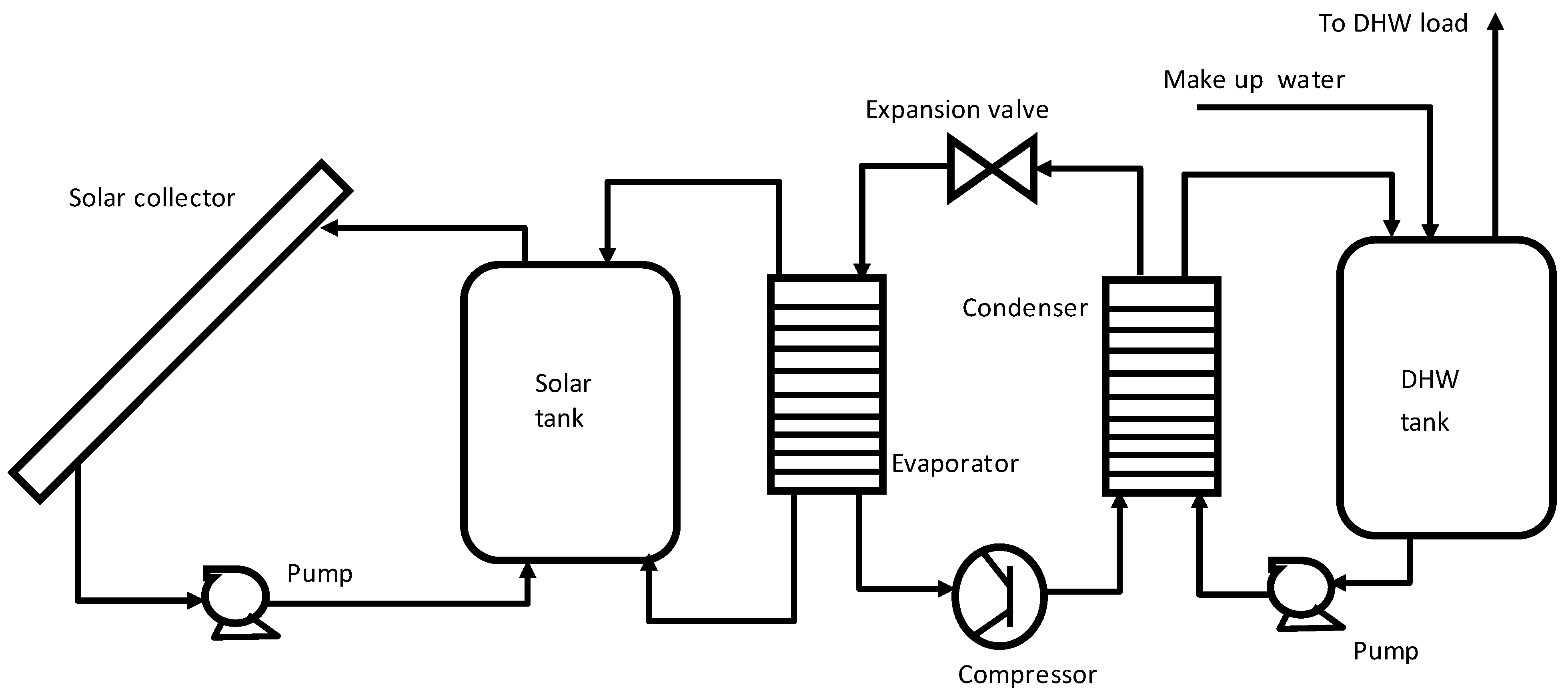
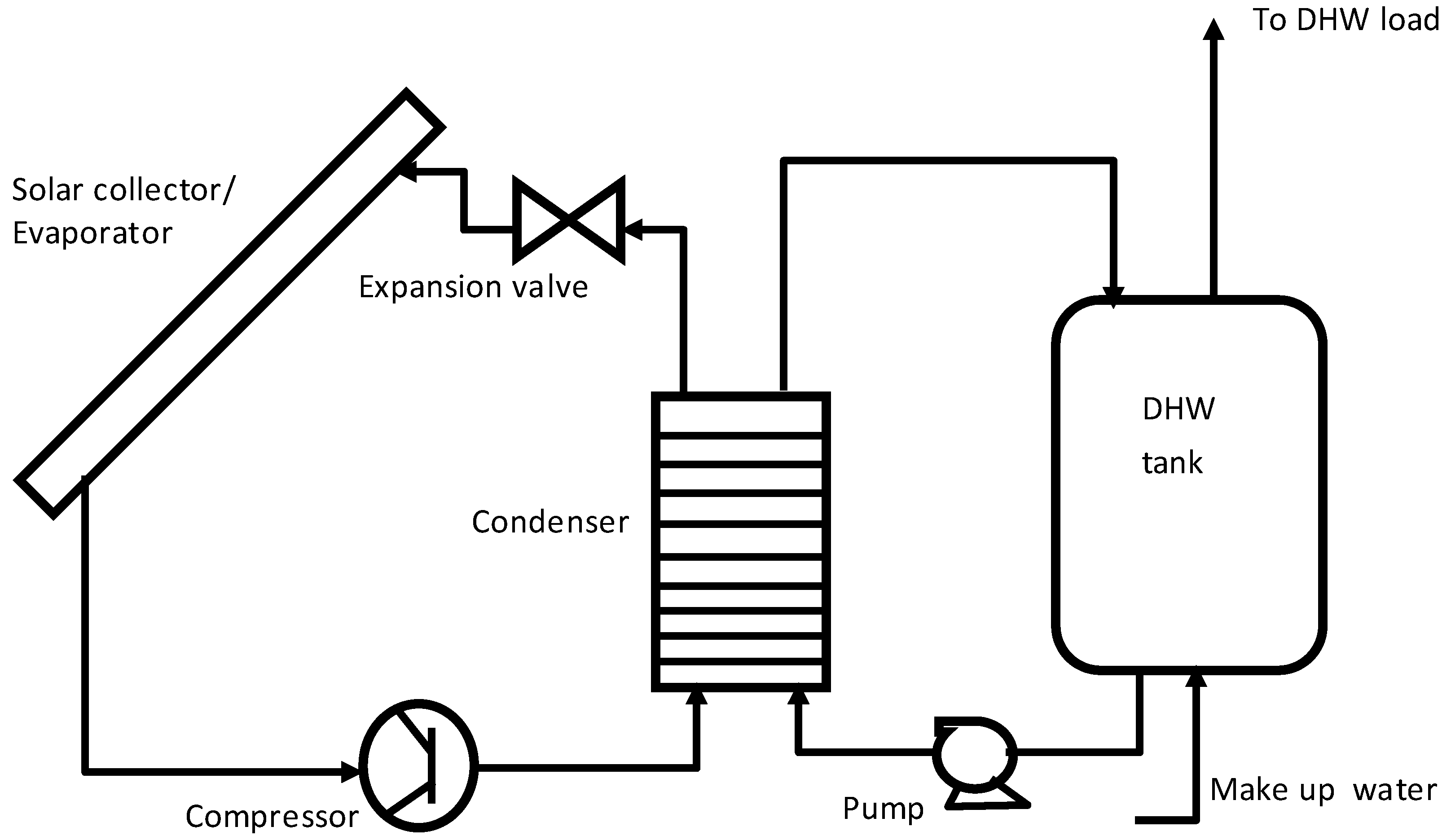


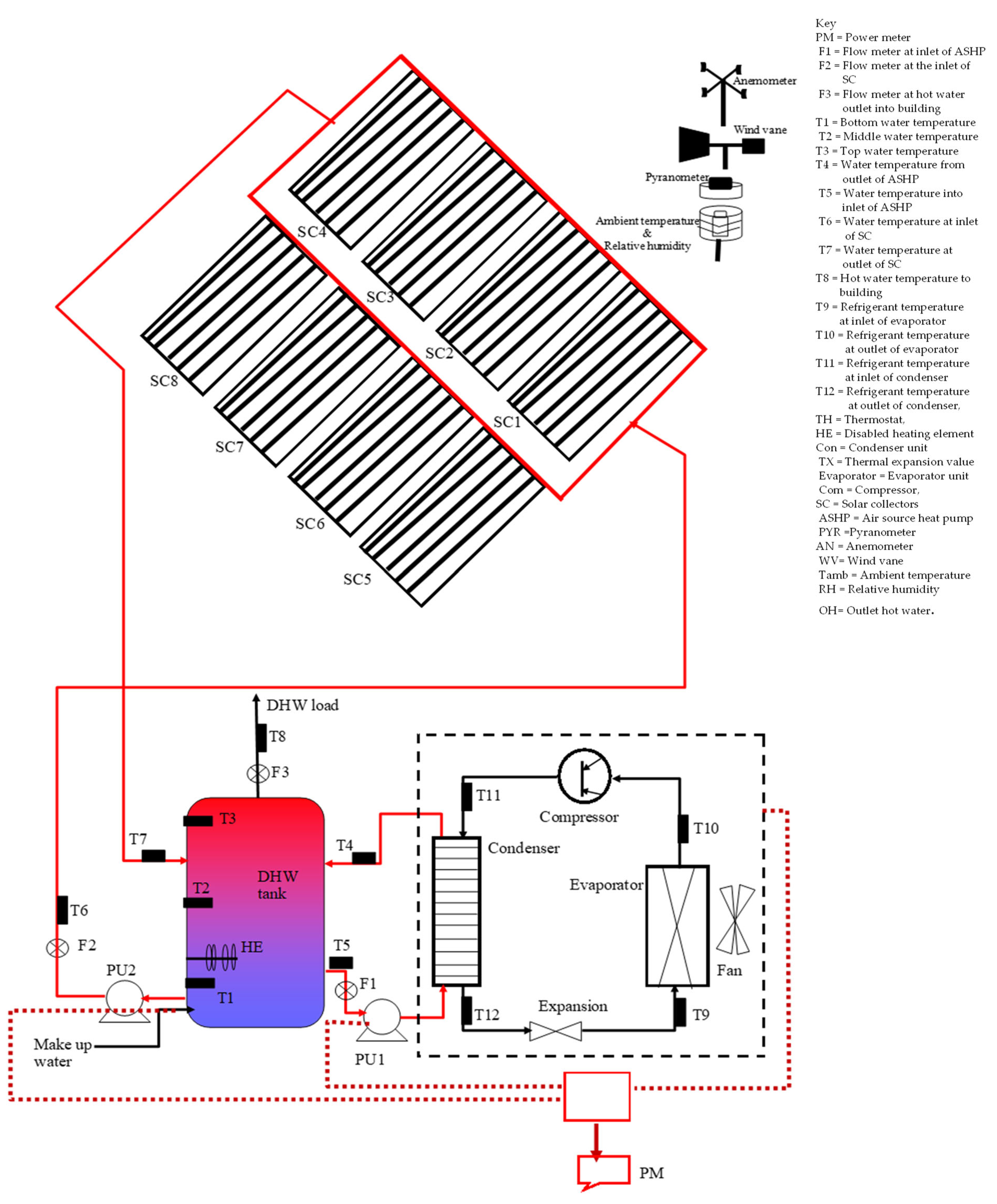
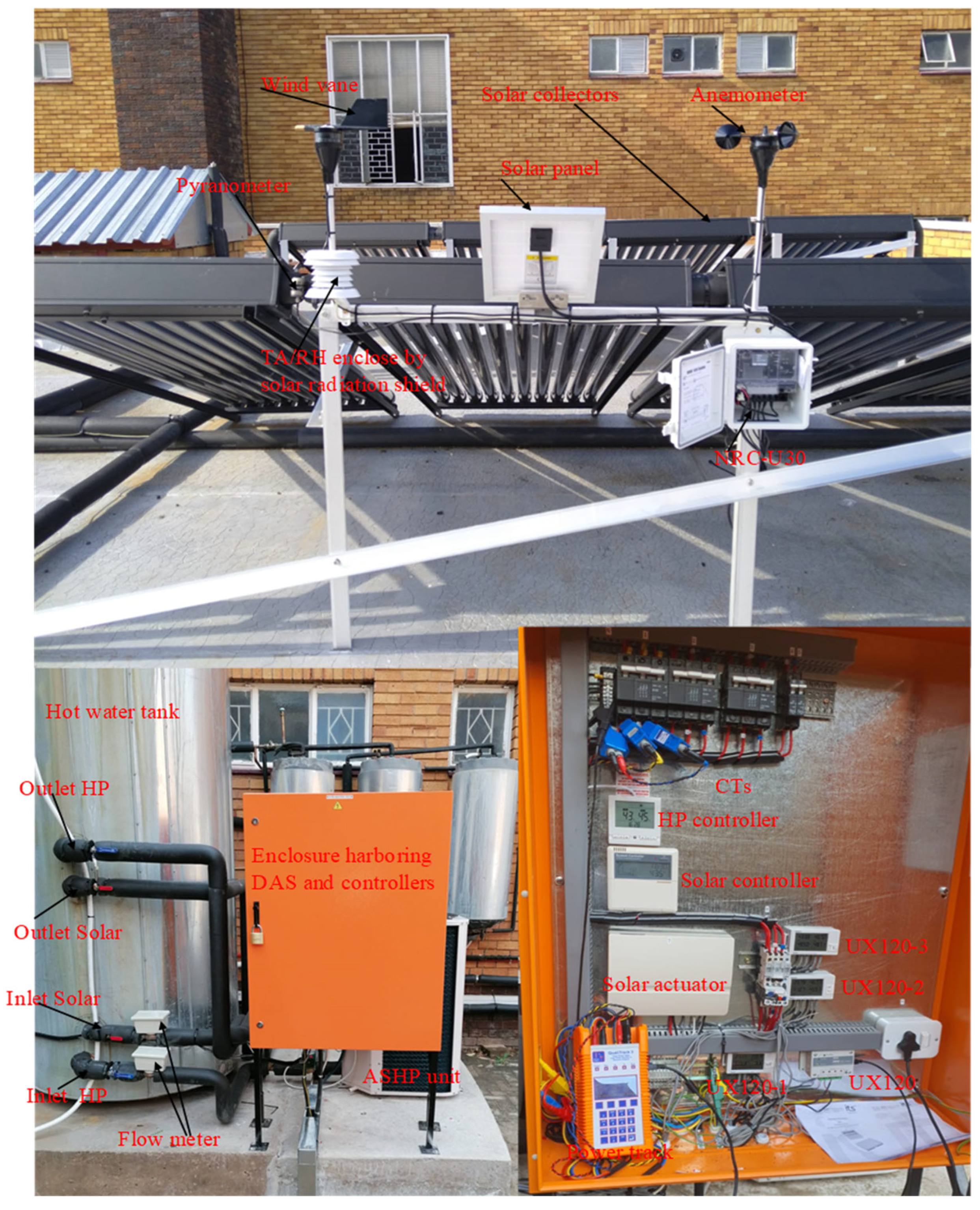
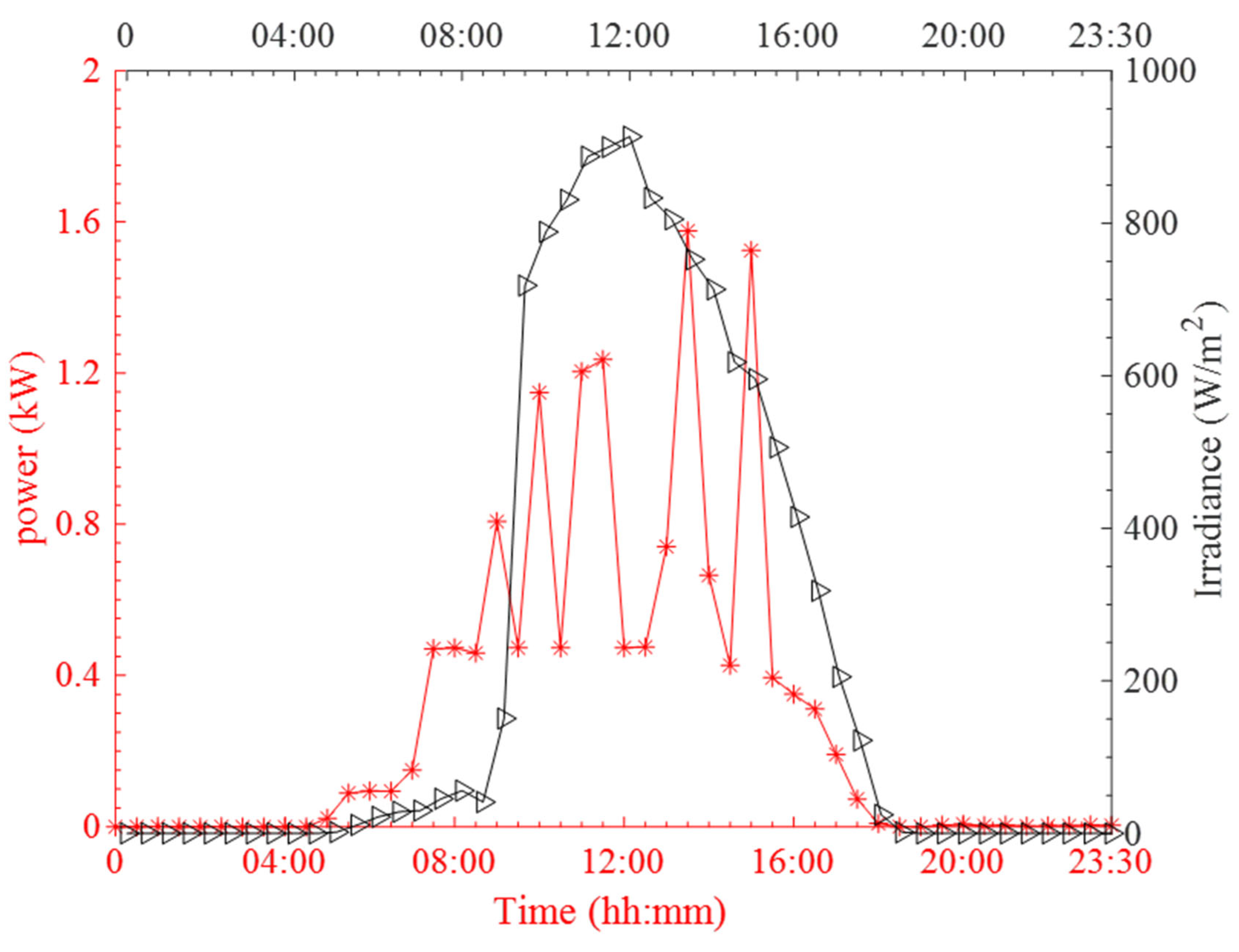



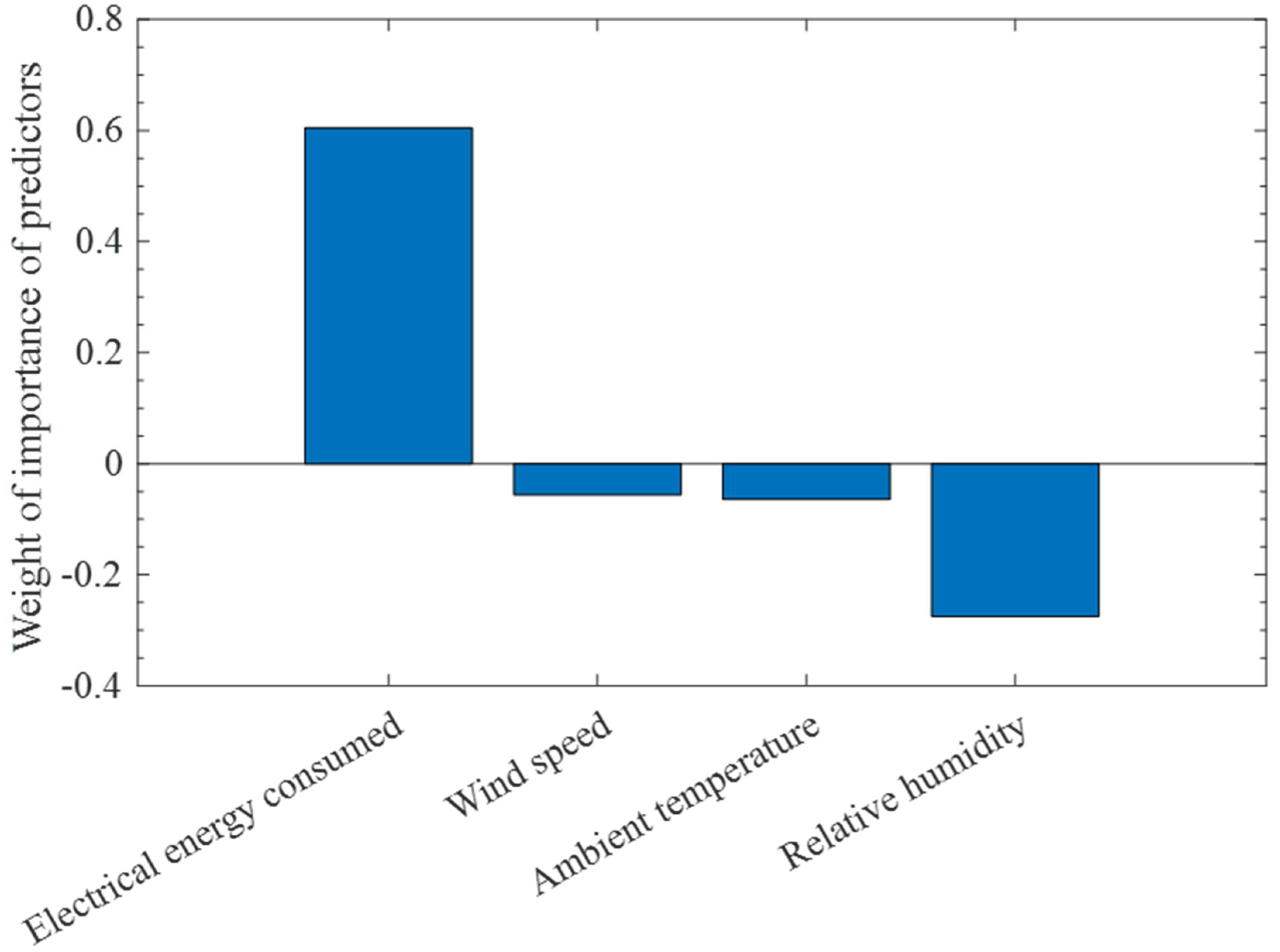
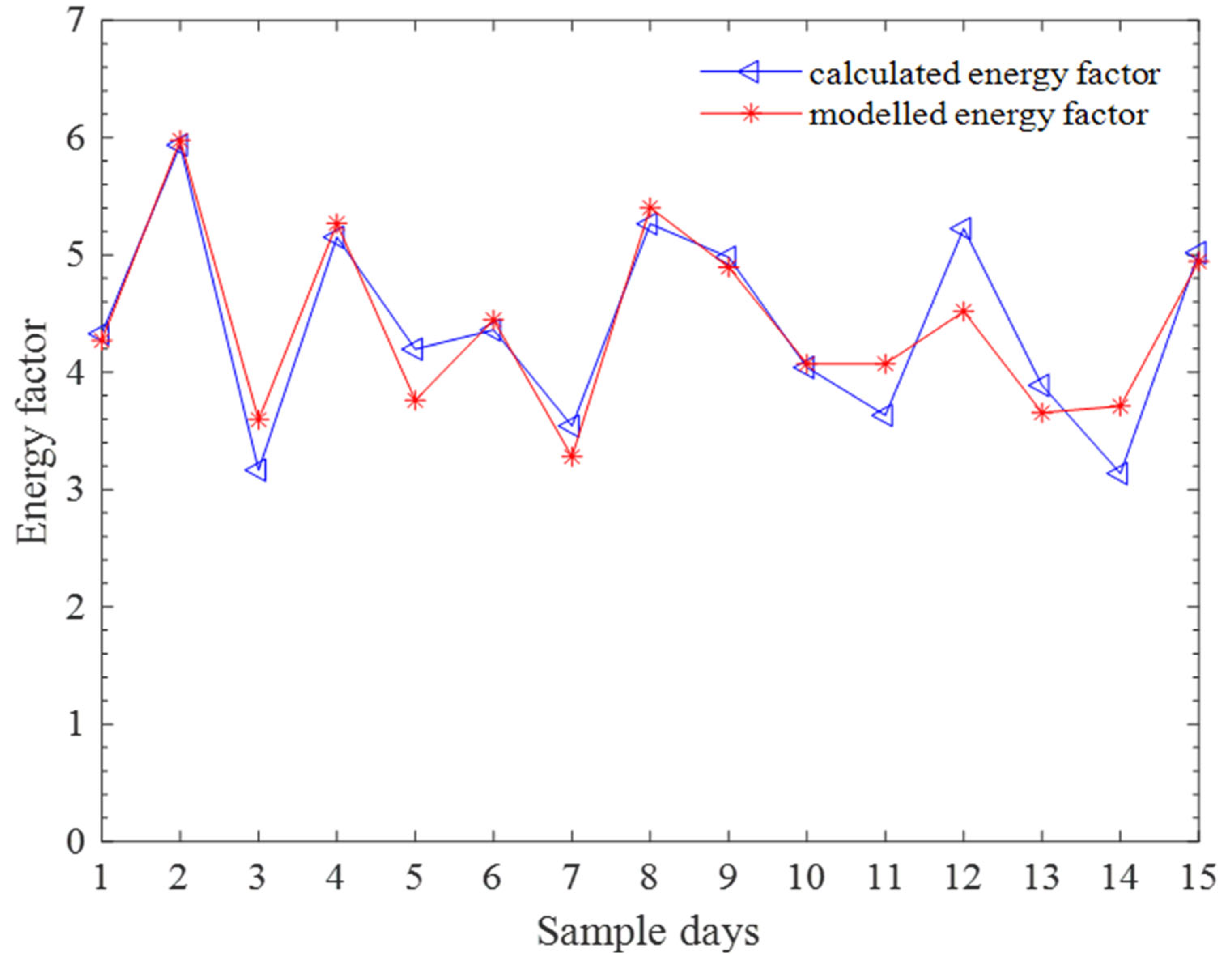

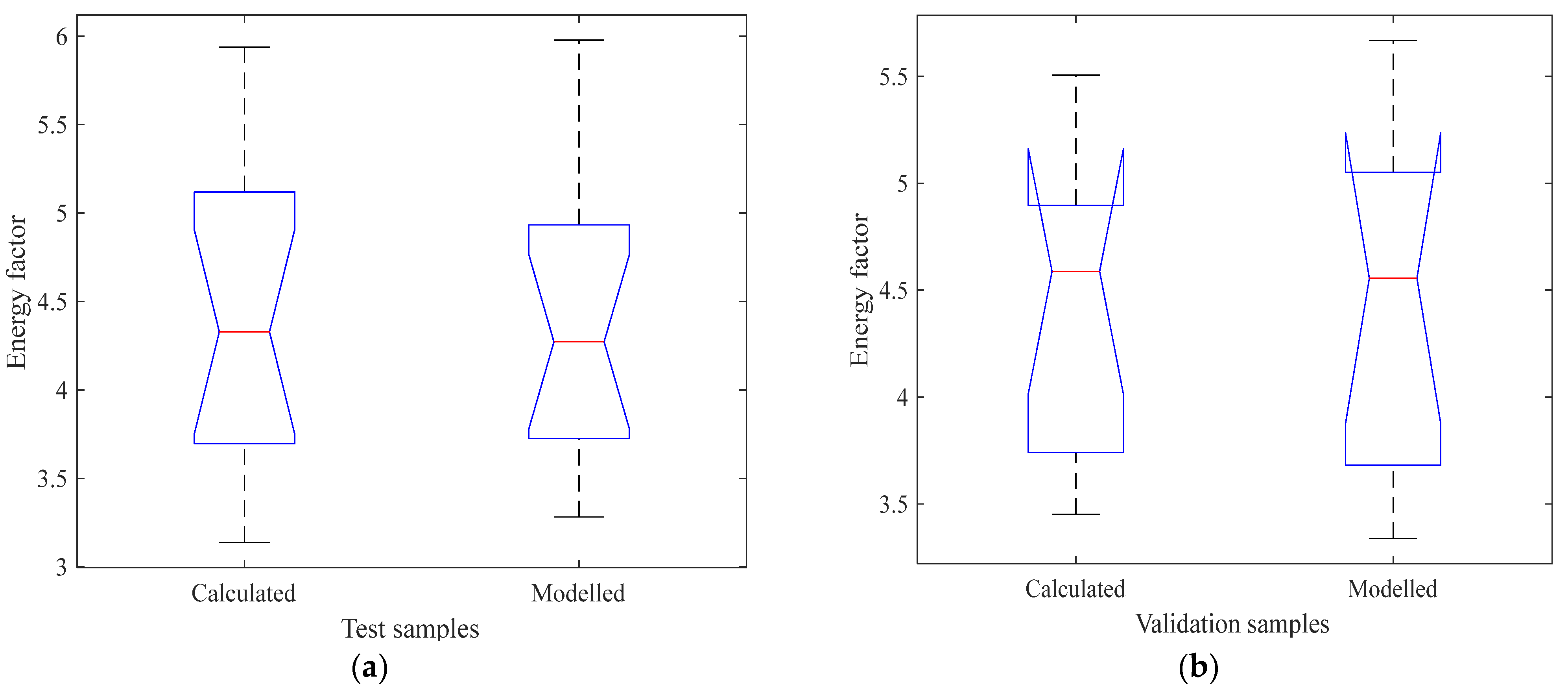
| Item | Material | Quantity |
|---|---|---|
| 1 | Power meter with inbuilt data logger (3 phase quality track analyzer, category A power meter from Advanced Monitoring Solution, Cape Town, SA) | 1 |
| 2 | Flow meters (T-MINOL-130-NL flow meter from Hobo corporation, Lakeville, MN, USA) | 3 |
| 3 | Temperature sensors (copper pipe thermocouple sensor TMC50-HD water and soil temperature sensors from Hobo corporation, Lakeville, MN, USA) | 12 |
| 4 | Ambient temperature and relative humidity sensor (TEMP/RH sensor, 12 bit, 2 m-S-THB-M002, from Hobo corporation, Lakeville, MN, USA) | 1 |
| 5 | 24 kW, 2000 L (Kwikhot electric boiler from Kwikhot PTY, SA) | 1 |
| 6 | 6.0 kW input ASHP unit (air source heat pump unit from ‘its solar’, Johannesburg, SA) | 1 |
| 7 | Evacuated tubes collectors (solar collectors from ‘its solar’ SA) | 8 |
| 8 | Controller systems (heat pump controller unit and solar collector controller unit, from ‘its solar’, Johannesburg, SA) | 2 |
| 9 | Pyranometer (silicon pyranometer 3m cable—S-LIB-M003 from Hobo cooperation, Lakeville, MN, USA) | 1 |
| 10 | Anenometer (wind speed sensor-S-WSB-M003 from Hobo cooperation, Lakeville, MN, USA) | 1 |
| 11 | Waterproof and weatherproof enclosures | 2 |
| 12 | Wind Vane (wind direction sensor-S-WDA-M003 from Hobo corporation, Lakeville, MN, USA) | 1 |
| 13 | Data logger (Hobo 4 channel pulse input logger -UX120-017M from Hobo corporation, Lakeville, MN, USA) | 1 |
| 14 | Data loggers (Hobo 4 channel analog logger -UX120-006M from Hobo corporation, Lakeville, MN, USA) | 3 |
| 15 | Data logger (U30 NRC logger weather station-U30-NRC-000-10-S from Hobo cooperation, Lakeville, MN, USA) | 1 |
| 16 | 5 W solar panel (solar panel 5 Watt-Solar-5W from Hobo corporation, Lakeville, MN, USA) | 1 |
| 17 | 4.5 V DC battery (U30 battery-HRB-U30-S100 from Hobo corporation, Lakeville, MN, USA) | 1 |
| 18 | Solar radiation shield (RS3-B Radiation shield-ODD72 from Hobo corporation, Lakeville, MN, USA) | 1 |
| 19 | USB-Cable (USB interface cable-cable-USBMB) | 1 |
| 20 | Hoboware pro software (version 3.7.25) (Hobo cooperation, Lakeville, MN, USA) | 1 |
| 21 | MATLAB software (version 2021a) | 1 |
| Quantity | Type A Uncertainty | Type B Uncertainty | Combined Uncertainty |
|---|---|---|---|
| Ambient temperature (°C) | ±0.200 | ±0.120 | ±0.233 |
| Relative humidity (%) | ±0.250 | ±0.140 | ±0.286 |
| Water flow rates measurements (L/min) | ±0.010 | ±0.006 | ±0.012 |
| Power consumed by split type ASHP system (kW) | ±0.130 | ±0.003 | ±0.130 |
| Water and refrigerant temperatures measurements (°C) | ±0.250 | ±0.120 | ±0.277 |
| Global solar radiation measurements (W/m2) | ±10.00 | ±4.350 | ±10.905 |
| Electrical energy consumed (kWh) | ±0.130 | ±0.025 | ±0.132 |
| Thermal energy gained (kWh) | ±0.190 | ±0.042 | ±0.195 |
| Coefficient of performance (COP) | ±0.260 | ±0.203 | ±0.330 |
| Solar fraction (SF) | ±0.060 | ±0.020 | ±0.080 |
| Energy factor (EF) | ±0.320 | ±0.223 | ±0.390 |
| SD | V-Ph2 (L) | Tin-HP (°C) | Tout-HP (°C) | Q-HP (kWh) | E-HP (kWh) | COP |
|---|---|---|---|---|---|---|
| 1 | 2971 | 55.35 | 59.93 | 6.669 | 1.980 | 3.368 |
| 2 | 3770 | 52.74 | 57.04 | 22.97 | 4.340 | 5.294 |
| 3 | 4020 | 52.86 | 55.93 | 5.210 | 2.070 | 2.517 |
| 4 | 3993 | 52.45 | 57.15 | 20.28 | 4.580 | 4.428 |
| 5 | 5027 | 52.02 | 56.89 | 10.65 | 2.990 | 3.562 |
| 6 | 4095 | 53.53 | 57.91 | 8.05 | 2.380 | 3.384 |
| 7 | 3804 | 53.16 | 57.67 | 5.33 | 1.790 | 2.979 |
| 8 | 2452 | 47.46 | 51.95 | 25.57 | 5.450 | 4.693 |
| 9 | 4387 | 53.02 | 56.80 | 15.67 | 3.64 | 4.305 |
| 10 | 4353 | 52.23 | 56.54 | 8.936 | 2.60 | 3.437 |
| 11 | 4353 | 52.27 | 55.57 | 7.782 | 2.57 | 3.028 |
| 12 | 3989 | 52.74 | 57.15 | 15.267 | 3.430 | 4.451 |
| 13 | 2971 | 51.99 | 55.06 | 4.759 | 1.520 | 3.131 |
| 14 | 5125 | 53.33 | 56.89 | 4.166 | 1.740 | 2.394 |
| 15 | 3028 | 49.85 | 52.94 | 16.574 | 3.920 | 4.228 |
| SD | Period (hh:mm) | Et (kWh) | Tamb (°C) | RH (%) | WS (m/s) | EF |
|---|---|---|---|---|---|---|
| 1 | 08:30–18:30 | 3.878 | 16.70 | 57.70 | 0.622 | 4.329 |
| 2 | 08:30–18:30 | 7.450 | 23.08 | 29.36 | 0.946 | 5.937 |
| 3 | 08:30–18:30 | 5.255 | 31.12 | 20.24 | 0.167 | 3.166 |
| 4 | 08:30–18:30 | 7.607 | 27.90 | 18.63 | 0.123 | 5.152 |
| 5 | 08:30–18:30 | 5.403 | 29.34 | 20.51 | 0.152 | 4.197 |
| 6 | 08:30–18:30 | 4.246 | 20.68 | 69.56 | 0.181 | 4.361 |
| 7 | 08:30–18:30 | 4.187 | 26.69 | 30.28 | 0.210 | 3.542 |
| 8 | 08:30–18:30 | 7.745 | 30.02 | 21.64 | 0.224 | 5.265 |
| 9 | 08:30–18:30 | 6.828 | 29.45 | 25.32 | 0.253 | 4.981 |
| 10 | 08:30–18:30 | 5.714 | 30.33 | 23.89 | 0.267 | 4.041 |
| 11 | 08:30–18:30 | 5.714 | 30.33 | 23.89 | 0.267 | 3.633 |
| 12 | 08:30–18:30 | 6.418 | 31.33 | 23.06 | 0.311 | 5.225 |
| 13 | 08:30–18:30 | 4.697 | 25.48 | 27.12 | 0.325 | 3.888 |
| 14 | 08:30–18:30 | 4.874 | 26.97 | 26.05 | 0.354 | 3.137 |
| 15 | 08:30–18:30 | 6.465 | 25.39 | 29.94 | 0.339 | 5.019 |
| Input Parameter | Symbols | Constants | Symbols | Scaling Values | Output |
|---|---|---|---|---|---|
| Forcing | 0.5822 | Energyfactor (EF) | |||
| Total electrical energy consumed | Et | Scaling | 0.6863 | ||
| Ambient temperature | Tamb | Scaling | −0.0368 | ||
| Relative humidity | RH | Scaling | 0.0234 | ||
| Wind speed | WS | Scaling | 0.4708 |
| SD | Period | Et (kWh) | Tamb (°C) | RH (%) | WS(m/s) | EF |
|---|---|---|---|---|---|---|
| 1 | 08:30–18:30 | 6.425 | 36.45 | 49.82 | 0.572 | 4.644 |
| 2 | 08:30–18:30 | 6.187 | 34.17 | 42.43 | 0.319 | 4.532 |
| 3 | 08:30–18:30 | 7.401 | 27.30 | 41.78 | 0.560 | 5.495 |
| 4 | 08:30–18:30 | 6.969 | 27.12 | 47.47 | 0.315 | 5.506 |
| 5 | 08:30–18:30 | 6.260 | 33.67 | 54.39 | 0.610 | 4.711 |
| 6 | 08:30–18:30 | 6.994 | 33.93 | 45.10 | 0.360 | 4.897 |
| 7 | 08:30–18:30 | 4.690 | 32.51 | 48.77 | 0.295 | 3.451 |
| 8 | 08:30–18:30 | 3.692 | 20.87 | 43.35 | 0.318 | 3.740 |
| 9 | 08:30–18:30 | 3.916 | 21.67 | 51.26 | 0.475 | 4.000 |
| 10 | 08:30–18:30 | 3.213 | 21.82 | 49.00 | 0.370 | 3.524 |
Disclaimer/Publisher’s Note: The statements, opinions and data contained in all publications are solely those of the individual author(s) and contributor(s) and not of MDPI and/or the editor(s). MDPI and/or the editor(s) disclaim responsibility for any injury to people or property resulting from any ideas, methods, instructions or products referred to in the content. |
© 2023 by the authors. Licensee MDPI, Basel, Switzerland. This article is an open access article distributed under the terms and conditions of the Creative Commons Attribution (CC BY) license (https://creativecommons.org/licenses/by/4.0/).
Share and Cite
Tangwe, S.; Mukumba, P.; Makaka, G. An Installed Hybrid Direct Expansion Solar Assisted Heat Pump Water Heater to Monitor and Modeled the Energy Factor of a University Students’ Accommodation. Energies 2023, 16, 1159. https://doi.org/10.3390/en16031159
Tangwe S, Mukumba P, Makaka G. An Installed Hybrid Direct Expansion Solar Assisted Heat Pump Water Heater to Monitor and Modeled the Energy Factor of a University Students’ Accommodation. Energies. 2023; 16(3):1159. https://doi.org/10.3390/en16031159
Chicago/Turabian StyleTangwe, Stephen, Patrick Mukumba, and Golden Makaka. 2023. "An Installed Hybrid Direct Expansion Solar Assisted Heat Pump Water Heater to Monitor and Modeled the Energy Factor of a University Students’ Accommodation" Energies 16, no. 3: 1159. https://doi.org/10.3390/en16031159
APA StyleTangwe, S., Mukumba, P., & Makaka, G. (2023). An Installed Hybrid Direct Expansion Solar Assisted Heat Pump Water Heater to Monitor and Modeled the Energy Factor of a University Students’ Accommodation. Energies, 16(3), 1159. https://doi.org/10.3390/en16031159






